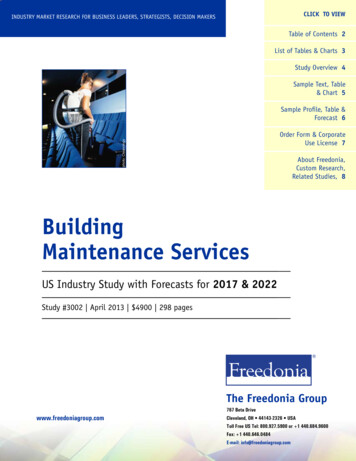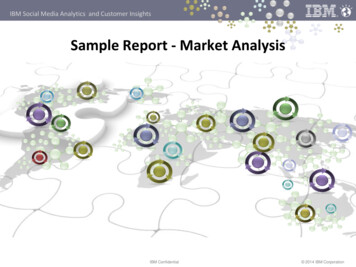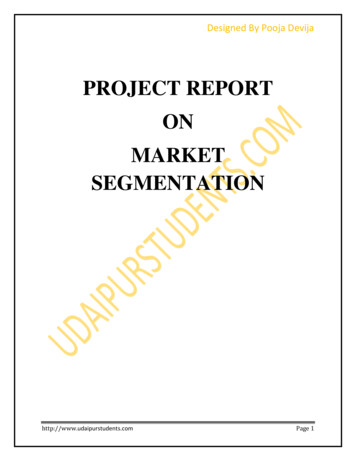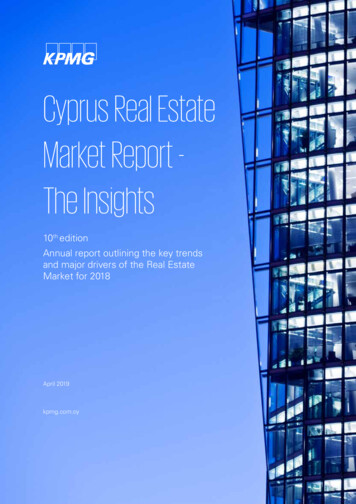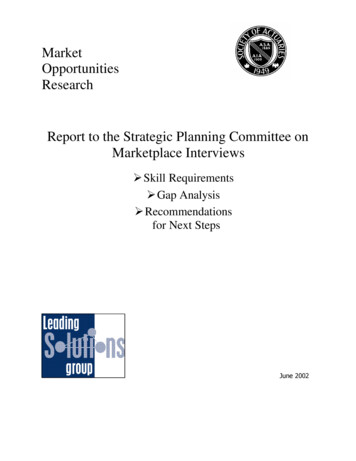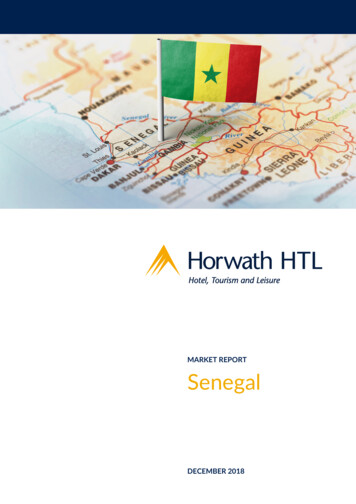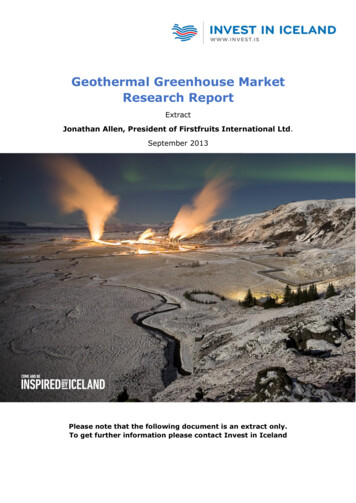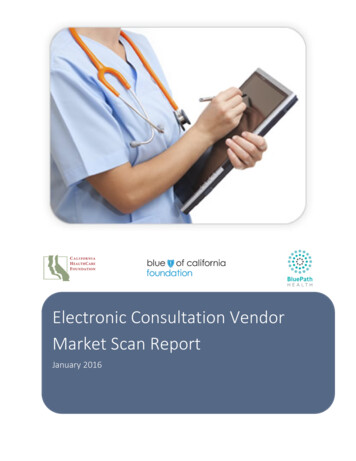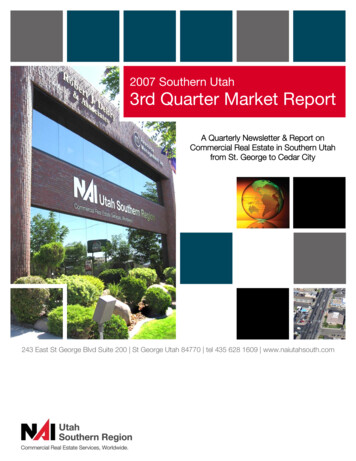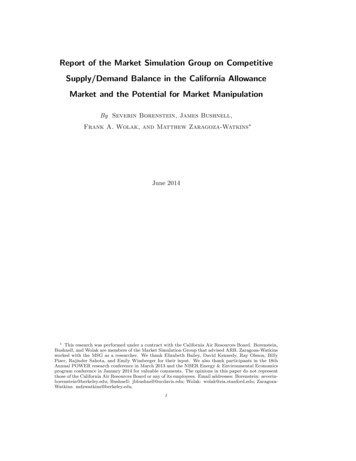
Transcription
Report of the Market Simulation Group on CompetitiveSupply/Demand Balance in the California AllowanceMarket and the Potential for Market ManipulationBy Severin Borenstein, James Bushnell,Frank A. Wolak, and Matthew Zaragoza-Watkins June 2014 This research was performed under a contract with the California Air Resources Board. Borenstein,Bushnell, and Wolak are members of the Market Simulation Group that advised ARB. Zaragoza-Watkinsworked with the MSG as a researcher. We thank Elizabeth Bailey, David Kennedy, Ray Olsson, BillyPizer, Rajinder Sahota, and Emily Wimberger for their input. We also thank participants in the 18thAnnual POWER research conference in March 2013 and the NBER Energy & Environmental Economicsprogram conference in January 2014 for valuable comments. The opinions in this paper do not representthose of the California Air Resources Board or any of its employees. Email addresses: Borenstein: severinborenstein@berkeley.edu; Bushnell: jbbushnell@ucdavis.edu; Wolak: wolak@zia.stanford.edu; ZaragozaWatkins: mdzwatkins@berkeley.edu.1
2MAY 2014EXECUTIVE SUMMARYCalifornia’s Cap and Trade market in greenhouse gases (GHG) is now in itsthird calendar year, with the first allowance auction taking place on November14, 2012 and compliance obligations commencing on January 1, 2013. A keydesign element of the system is its limited price-collar mechanisms that place softlower and upper bounds of allowance prices. To date the market prices have heldat or near the lower bound “floor” prices established by the allowance auctionreserve price. However, the market will be entering important new phases overthe next 18 months. The first firm information on covered emissions during thefirst compliance phase (2013-2014) will emerge in November of 2014. Comingnear the end of this compliance phase, the release of this information is the firstopportunity for the market to confirm expectations of the supply and demandbalance of allowances during the first phase. Starting in 2015, the market willexpand to include several new sectors, most significantly transportation fuels andthe bulk of natural gas consumption in the state. It is therefore important toanticipate any possible shocks to the market that can arise as it matures andexpands over the course of the next two years.One central issue is the status of the price-collar mechanisms. While the detailsof California’s price-collars are described in regulations developed by the California Air Resources Board (ARB), recently approved regulatory changes would alterthe exact manner in which the price ceiling – known as the allowance price containment reserve (APCR) mechanism – would be applied and the degree to whichit could mitigate uncertainty over prices.1 A key question relating to this issueis the extent to which either the auction reserve price or APCR price is likely tobe relevant, that is, the probabilities that market prices may be near the price1 The regulations are available at: http://www.arb.ca.gov/cc/capandtrade/september 2012 is from the Emissions Market Assessment Committee dated September 20, 2012 rketassessment/pricecontainment.pdf.
MSG REPORT ON SUPPLY/DEMAND AND POTENTIAL MANIPULATION3floor or the APCR soft price ceiling.2 A second key question is whether somemarket participants may be able to strategically change the allowance price, inparticular by buying more allowances than they need and withholding them fromthe market in order to sell a portion later at a higher price.In this report, we simulate distributions of possible market outcomes in order to address these questions. We first develop estimates of the distribution ofcompetitive allowance prices and the probabilities that one of the price containment mechanisms may be binding. A key factor driving these probabilities is theamount by which GHG-producing entities will reduce their emissions. This reduction is likely to be a highly non-linear function of allowance price. Specifically,we find that a large quantity of emissions reductions are mandated by programsauxiliary to the cap and trade mechanism, and will therefore be available at orbelow the auction reserve price. Other businesses can reduce their need to purchase allowances at a cost that is below or only slightly above the auction reserveprice. Relatively little additional emissions abatement is likely to be available asthe price climbs, at least before the price rises high enough to trigger additionalsupply of allowances from the price containment reserve.Our key simulation findings are1) The steeply rising cost of emissions abatement between the auction reserveprice floor and the price containment reserve ceiling, along with relativelyinflexible supply of abatement below the price containment reserve, impliesa bi-modal distribution of prices with most of the probability mass at eitherlow or high price outcomes.2) Under most scenarios, the most likely 2020 market price will be very closeto the auction reserve price floor.3) However, under all scenarios, there is a smaller but significant risk that theallowance price containment reserve will be exhausted at or before 2020.2 As described below, the APCR makes a limited number of extra allowances available if the pricehits certain levels.
4MAY 2014For scenarios in which there is low or medium availability of carbon offsetsand relatively little reshuffling of electricity imports, this probability rangesfrom as 4%-25%.4) The probability of reaching, but not exhausting, the APCR by 2020 fallsbetween 8% and 31% under low and medium abatement scenarios. We findthere is low risk of exhausting the APCR before the third compliance phase,which begins in 2018.5) There are small but significant probabilities that the market could reachthe APCR during one of the first two compliance phases. Under our lowand medium abatement scenarios, there is a 2%-4% chance of reaching theAPCR (assuming no strategic withholding behavior by market participants,which we investigate later) during the first compliance phase. Under ourlow and medium abatement scenarios, the probability of reaching the APCR(assuming no withholding) during the second compliance phase ranges from4%-17%.6) There is a straightforward mechanism in which firms can withhold allowancesfrom one phase of the market by banking them into compliance accountsfor future compliance phases. We study the risks that such strategies couldinflate prices during the first and second compliance phases. The largestrisk is that one (or more) of a small number of large firms acquires significantly more allowances than it requires for the first compliance phase, anddeposits these extra allowances into compliance accounts for use in laterperiods. This could result in 10% of available allowances or more beingremoved from an approximately 330 million metric tons (MMT) market inthe first compliance period. Such a strategy, if attempted, would increasethe probability of reaching the APCR from 2% (absent withholding) up toabout 7% or higher with medium abatement and from 4% to about 13% or
MSG REPORT ON SUPPLY/DEMAND AND POTENTIAL MANIPULATION5higher under a low abatement scenario.3This strategy would be most likely to affect the allowance price for the firstcompliance period during 2015, after the first compliance period ends butbefore the final surrender of allowances for this period.7) During the second compliance phase, a similar strategy could increase therisk of needing to access the APCR from around 15% to as much as 30% orhigher.We provide several recommendations to reduce the risk of very high allowanceprices due to either the competitive supply/demand balance or a withholdingstrategy. It is important to emphasize that the higher prices are allowed to rise,the more potentially profitable a withholding strategy becomes. Therefore an unambiguous policy that credibly limits the maximum allowance price is importantto market stability and a strong deterrent to attempts at market manipulation.Our major recommendations are:1) Establish policies that reinforce the viability of the allowance price containment reserve. The recently adopted rule changes that make adjustmentsto the APCR only address transient shortfalls and therefore do not addressthe threat that there could be a supply/demand mismatch for the entire 8year program.4 If there were not enough allowances over the 8-year periodto cover the cumulative emissions under the cap, then there would be nopolicy in place to further restrain prices. It is likely that an ad-hoc government intervention into the market might occur under such a circumstance.This would prove to be extremely disruptive to both the market and to thebroader policy goals of AB 32.3 The impact of withholding depends very much on the exact strategy a firm would pursue, which isdifficult to predict. It is also difficult to know how large a postion a firm could acquire without raisingthe acquistion price it would face. As a result, we report ranges of the possible impact of withholding,but do specify precise estimates.4 See pandtrade15dayattach1.pdf.
6MAY 2014We therefore recommend that a policy be established to ensure that theAPCR could not be exhausted. The Air Resources Board should standready to expand the pool of allowances in order to maintain the marketprice at or below the highest price step of the APCR. Two alternatives thatcould achieve this goal are allowing sales of post-2020 compliance periodallowances or allowing direct or indirect use of compliance instruments fromother GHG markets such as the European Union Emissions Trading System(EU-ETS) or the Regional Greenhouse Gas Initiative (RGGI) under suchcircumstances.2) Allow Conversion of Allowance Vintages.Currently, market participants are not allowed to use allowances from latervintages for compliance in earlier phases. For example a vintage 2015 allowance cannot be used for compliance obligations in phase I, which concludes on December 31, 2014, but for which final surrender doesn’t occuruntil late in 2015. This boundary between phases creates the prospect oftransitional shortages in which allowance prices in the expiring phase riseto the APCR while current vintage allowance remain near the price floor.As we demonstrate, the potential for withholding increases the probabilityof such an outcome.A second concern with the current design is the potential that allowancescould end up inefficiently owned ex post. As firms acquire allowances according to their expectations of needs, shocks to individual firms or evensectors could result in too few allowances from a current phase being available to some sectors while others hold a surplus they are unable to sell, iftheir surplus is held in compliance accounts rather than holding accounts.Conversion – for a fee – of the vintages of allowances held by market participants would greatly reduce the risk and consequence of both problems.Under this proposal firms would be allowed, for instance, to purchase 2015 or
MSG REPORT ON SUPPLY/DEMAND AND POTENTIAL MANIPULATION7later vintage allowances during 2015 and convert them to meet their phaseI obligations, for which final allowance surrender would occur in November2015. To prevent stakeholders from casually undertaking such conversions,a cost in terms of either a conversion fee or the number of allowances surrendered could be imposed. For example, ARB could require 1.25 vintage2015 allowances be converted to yield 1.0 2014 vintage allowance, therebyimposing an implicit 25% cost on the conversion. Alternatively, a conversion fee, for example 2.50 or 5 per allowance, could be applied to eachconverted allowance. Firms would only avail themselves of this option ifthe allowance price in the expiring phase rises above the price of the latervintage allowance by an amount greater than the conversion fee. At thesame time, this option would bound the extent to which prices in the expiring phase could rise above later vintage allowance prices. This wouldgreatly reduce the incentive to attempt to raise prices in the expiring phaseby withholding allowances from that phase.The proposal would also address accidental over-compliance by some participants, as well as strategic withholding, either of which could create anartificial shortage at the end of a compliance period. Firms would be ableto purchase future vintages (at a premium) to meet their needs.3) Maximize the Timeliness and Quality of Information Available to the Market. Currently the market suffers from opacity in several important areas.First, there is almost no way to observe, even indirectly, the emissions associated with electricity imports and the only source of official informationwill arrive with up to a nearly two-year lag on the market. Second, currentproposals would limit the public availability of information on the allowanceholdings of individual firms. We recommend steps be taken to increase thefrequency with which key emissions figures, particularly from electricity imports, be provided to the market. We also recommend that if individualallowance holdings must be held confidential, statistics on the overall con-
8MAY 2014centration of allowance holdings be made available. In this way, marketparticipants would be able to detect attempts by one firm to acquire a substantial long position and take measures to defend themselves against anyattempts at withholding allowances from the market.
MSG REPORT ON SUPPLY/DEMAND AND POTENTIAL MANIPULATIONI.9INTRODUCTIONCalifornia’s Cap and Trade market in greenhouse gasses (GHG) is now in itsthird calendar year, with the first allowance auction taking place on November 14,2012 and compliance obligations commencing on January 1, 2013. The quantityof ava
Our key simulation ndings are 1) The steeply rising cost of emissions abatement between the auction reserve price oor and the price containment reserve ceiling, along with relatively in exible supply of abatement below the price containment reserve, implies a bi-modal distribution of prices with most of the probability mass at either low or high price outcomes. 2) Under most scenarios, the .


